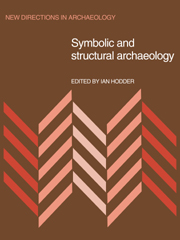Book contents
- Frontmatter
- Contents
- List of contributors
- Preface
- Part one The development of theory
- Part two The search for models
- 5 Matters material and ideal
- 6 House power: Swahili space and symbolic markers
- 7 The interpretation of spatial patterning in settlement residues
- 8 Decoration as ritual symbol: a theoretical proposal and an ethnographic study in southern Sudan
- 9 Structures and strategies: an aspect of the relationship between social hierarchy and cultural change
- 10 Mortuary practices, society and ideology: an ethnoarchaeological study
- Part three Application: the analysis of archaeological materials
- Part four Commentary
- Index
9 - Structures and strategies: an aspect of the relationship between social hierarchy and cultural change
Published online by Cambridge University Press: 27 February 2010
- Frontmatter
- Contents
- List of contributors
- Preface
- Part one The development of theory
- Part two The search for models
- 5 Matters material and ideal
- 6 House power: Swahili space and symbolic markers
- 7 The interpretation of spatial patterning in settlement residues
- 8 Decoration as ritual symbol: a theoretical proposal and an ethnographic study in southern Sudan
- 9 Structures and strategies: an aspect of the relationship between social hierarchy and cultural change
- 10 Mortuary practices, society and ideology: an ethnoarchaeological study
- Part three Application: the analysis of archaeological materials
- Part four Commentary
- Index
Summary
Miller describes a model of emulation, in which material items associated with elites are copied by lower levels within society, so necessitating further symbolic elaboration by the elite in order to maintain structural and categorical contrasts. In the modern western world, the structure of society is reproduced in the strategies of individuals seeking reputation and status and one of the mechanisms used to achieve this is association with the language traits and material items of the elite. Material items are implicated in the emulation of higher castes within a village in India and an analysis of the pottery made and used in the village demonstrates that the organisation of pottery categories (in terms of colour and form) relates to the structure of the social hierarchy. This association is related to the emphasis on purity in the Hindu context, which, as in Braithwaite's study, is expressed in food and drink transactions. The proliferation of pottery types is not tied directly to utilitarian functions and may in fact decrease the efficiency of certain activities. Hierarchy may generate strategies of emulation, or the prevention of copying new forms, but only if a given set of material items is used to express and form status relationships. In a particular archaeological context, Miller shows how the process of emulation has structured the expression of rules of purity and pollution in material forms over two millennia.
Archaeologists have always been concerned with the processes that underlie cultural change: to identify patterns in dynamic processes and to postulate mechanisms that might give rise to these patterns.
- Type
- Chapter
- Information
- Symbolic and Structural Archaeology , pp. 89 - 98Publisher: Cambridge University PressPrint publication year: 1982
- 22
- Cited by



